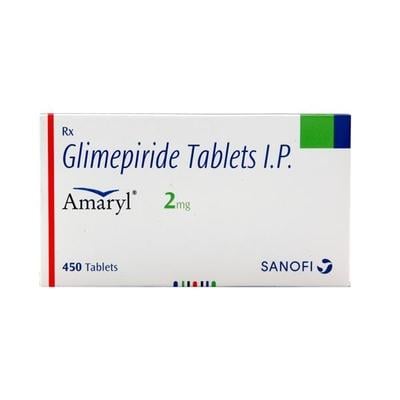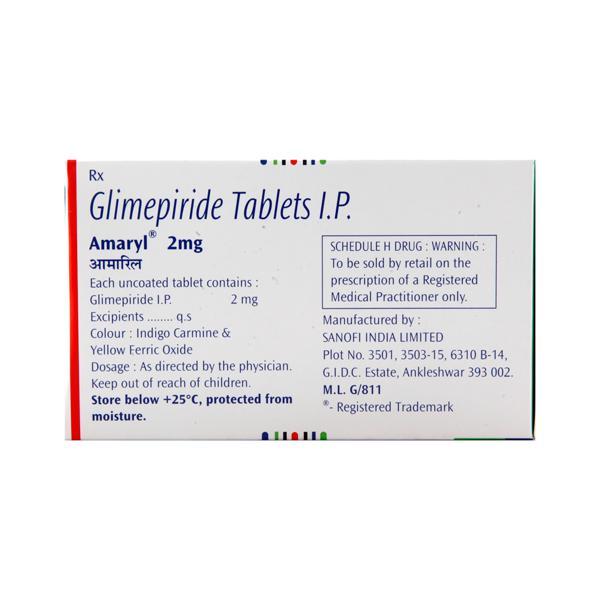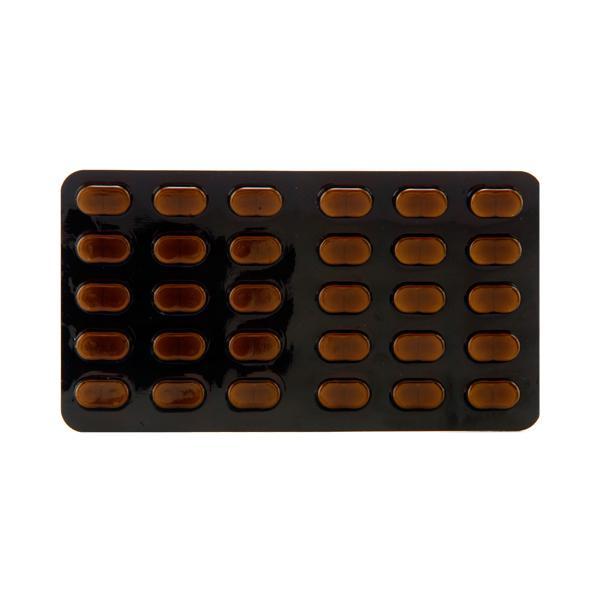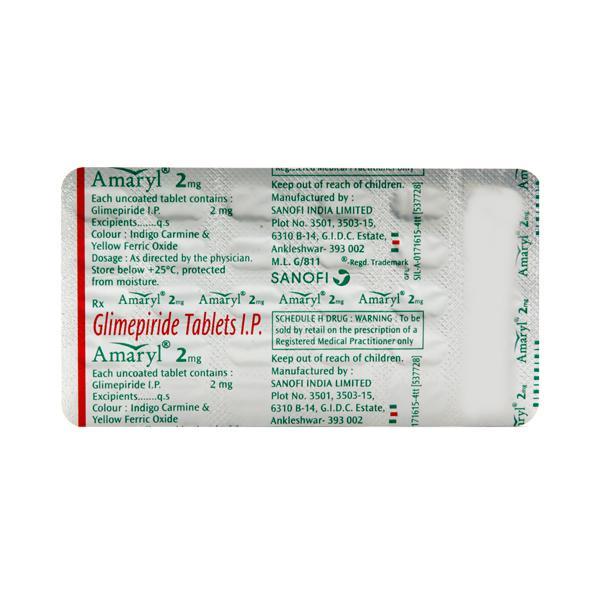

Netmeds First Membership
Quick Links
Introduction About AMARYL 2MG TABLET
Amaryl 2mg Tablet 30’s (Glimepiride) is a commonly prescribed oral anti-diabetic medicine, primarily used as part of personalized plans for those experiencing consistently elevated blood sugar levels due to type 2 diabetes mellitus. It fits well into daily routines for people seeking better blood sugar management beyond dietary changes and exercise, when these steps alone aren’t enough to maintain healthy glucose levels. The medicine works by helping the body produce more insulin, aiding in the regulation of sugar throughout the day.
Amaryl 2mg Tablet is ideally considered for adult patients with type 2 diabetes who retain some pancreatic function and do not have severe kidney or liver conditions. People with existing heart conditions or thyroid imbalances should consult their healthcare provider for appropriate monitoring and dosage adjustments. The tablet is taken once daily, shortly before or with the first main meal—most often breakfast—to allow optimal insulin response in sync with food intake. Consistent use along with regular blood sugar monitoring, healthy eating habits, and physical activity is recommended for best results.
It’s important to follow specific precautions when using Amaryl 2mg Tablet to support safe and effective administration. Patients should not skip meals, as this increases the risk of a low blood sugar episode (hypoglycemia). Carrying a source of fast-acting carbohydrates, like juice or glucose tablets, is advised in case of hypoglycemic symptoms such as shakiness, sweating, or dizziness. Special caution is advised for those engaged in driving or operating machinery due to possible drowsiness during low blood sugar events. Regular liver and kidney function checks and communication about all concurrent medications are essential to minimize adverse effects.
For those who are pregnant or breastfeeding, Amaryl 2mg Tablet is generally not recommended, as there is limited information regarding its safety in these conditions. Alternatives, such as insulin, may be preferable during pregnancy. If a breastfeeding patient must use Glimepiride, close monitoring of the infant for changes in feeding, responsiveness, or unusual symptoms is critical. Common side effects include mild hypoglycemia, headache, nausea, dizziness, and occasional weakness, which can usually be managed by following medication and dietary instructions closely
Uses Of AMARYL 2MG TABLET
- Lowers blood sugar in adults with type 2 diabetes. (in adjunct with diet and exercises)
Benefits of AMARYL 2MG TABLET
Supports daily blood sugar control
Amaryl 2mg Tablet helps the pancreas produce more insulin, which assists in moving glucose from the bloodstream into cells. This action supports maintaining stable blood sugar levels throughout the day, especially when combined with a balanced diet and regular physical activity.
Aids long-term diabetes management
By assisting in consistent blood sugar regulation, Amaryl can contribute to better overall glycemic control over extended periods. This helps patients manage type 2 diabetes effectively as part of a comprehensive care plan involving lifestyle changes and regular monitoring.
Lowers risk of diabetes-related complications
Maintaining blood sugar within recommended ranges with Amaryl can reduce the likelihood of developing complications such as nerve damage, kidney problems, and heart issues that are commonly linked to poorly controlled diabetes. Proper use as prescribed reduces these risks by supporting stable glucose levels.
How AMARYL 2MG TABLET Works
How does Amaryl 2mg Tablet work for blood sugar
Amaryl 2mg Tablet works by stimulating the pancreas to release more insulin, a hormone crucial for lowering blood sugar levels. It binds to specific receptors on pancreatic beta cells, causing the closure of ATP-sensitive potassium channels. This action triggers a chain reaction that leads to the release of insulin, which helps move glucose from the bloodstream into cells, thereby reducing blood sugar.
Improving Glucose Uptake Through Peripheral Tissues
Besides increasing insulin secretion, Amaryl enhances the sensitivity of peripheral tissues like muscles and fat to insulin. This improved sensitivity facilitates better uptake and utilization of glucose by these tissues, promoting more effective blood sugar control. This dual effect supports the body's ability to regulate glucose levels more efficiently.
How to use AMARYL 2MG TABLET
Recommended Dosage guidelines
- The recommended starting dose of Amaryl 2mg Tablet is 1 mg or 2 mg once daily.
- Dose should be taken with breakfast or the first main meal of the day to reduce the risk of low blood sugar.
- Patients at increased risk for hypoglycemia, such as the elderly or those with kidney impairment, should start at 1 mg once daily.
- Dose increments of 1 mg or 2 mg may be made based on blood sugar response, but not more frequently than every 1–2 weeks.
- The maximum recommended dose is 8 mg once daily.
- Regular monitoring of blood sugar levels is important during dose adjustments.
How and When to Take Amaryl
- Take the tablet once daily, preferably shortly before or with the first substantial meal.
- Maintain a consistent schedule every day to optimize effectiveness and reduce side effects.
- Do not skip meals after taking Amaryl to prevent symptoms of hypoglycemia.
Special Considerations for Elderly or Kidney Impairment
- In elderly patients those with kidney impairment start on the lowest dose of 1 mg daily due to increased sensitivity and risk of hypoglycemia.
- Dose titration in these populations should be gradual and conservative, with close monitoring of blood sugar levels.
- Kidney function tests and regular clinical evaluations should guide ongoing dose adjustments.
- Extra caution is advised for elderly patients who may have other comorbidities or are on multiple medications.
What if I forgot to take AMARYL 2MG TABLET
If a dose of Amaryl 2mg Tablet is missed, take it as soon as it is remembered. However, if it is almost time for the next scheduled dose, skip the missed dose and continue with the regular dosing schedule. Do not take a double dose to make up for the missed one, as this may increase the risk of low blood sugar (hypoglycemia). Setting medication reminders, like alarms or notes, can help reduce missed doses.
Overdose
Taking more Amaryl 2mg Tablet than prescribed can lead to serious side effects, primarily severe hypoglycemia, which may cause symptoms such as confusion, sweating, trembling, dizziness, loss of consciousness, or seizures. Immediate medical attention is needed in case of overdose. Treatment typically involves prompt administration of glucose. Patients and caregivers should be informed on managing hypoglycemia and the use of glucagon injections for emergencies. It is critical not to exceed the prescribed dose and to follow the doctor's instructions carefully.
Side Effects Of AMARYL 2MG TABLET
Common side effects of AMARYL 2MG TABLET:
- hypoglycemia (low blood sugar levels)
When to Seek Medical Attention?
Stop taking AMARYL 2MG TABLET and contact your doctor immediately if you experience any of the following side effects:
- severe allergic reaction (inflammation of blood vessels, skin rash, swelling of the face, eyelids, lips, tongue or throat which causes difficulty in breathing or swallowing, drop in blood pressure)
- signs of liver problems (such as fever, yellowing of skin and whites of the eyes, weakness, fatigue, weight loss and loss of appetite)
- increased skin sensitivity to sun
- signs of severe decrease in blood sugar level (such as confusion, headache, excessive sweating, clammy skin, trembling, weakness, double vision, excessive hunger, nausea, vomiting, problems in sleeping, feeling agitated, unable to concentrate, drowsiness, slowed reactions, depression, trouble seeing or speaking, paralysis, numbness, dizziness, hallucinations, difficulty in breathing, slowed or faster heartbeat with chest pain)
How To Manage Side Effects
Hypoglycemia
- Consume fast-acting carbohydrates (e.g., fruit juice, glucose tablets) immediately at the onset of hypoglycemia symptoms.
- Wait 15 minutes and recheck blood sugar; if still low, repeat carbohydrate intake.
- Once blood sugar normalizes, eat a small meal or snack to stabilize levels.
- Always carry quick sources of sugar for emergencies.
- Seek emergency help if severe symptoms occur (loss of consciousness, seizures).
Warning & Precautions
Pregnancy
Monitoring requiredThere are no adequate and well-controlled studies in pregnant women. AMARYL 2MG TABLET should be used during pregnancy only if the potential benefit justifies the potential risk to the fetus.
Breastfeeding
Consult your doctorIt is not known whether AMARYL 2MG TABLET is excreted in human milk. Consult your doctor for advice.
Driving and Using Machines
Use with CautionDo not drive or operate any heavy tools or machines if your ability is affected by the medicine.
Alcohol
ContraindicatedAvoid consumption of alcohol while taking AMARYL 2MG TABLET as it may increase the risk of unwanted side effects.
Kidney
Consult your doctorAMARYL 2MG TABLET is not recommended for use in patients with severe kidney problems. It should be used with caution in patients with other kidney problems.
Liver
Consult your doctorAMARYL 2MG TABLET is not recommended for use in patients with severe liver problems. It should be used with caution in patients with other liver problems.
Allergy
ContraindicatedDo not take AMARYL 2MG TABLET if you are allergic to Glimepiride or any other ingredients of this medicine.
Use In Pediatrics
ContraindicatedAMARYL 2MG TABLET is not recommended in pediatric patients because of its adverse effects on body weight and hypoglycemia.
Use In Geriatrics
Use with CautionAMARYL 2MG TABLET should be used with caution in elderly patients (aged above 65 years).
Other Warnings for AMARYL 2MG TABLET
Before taking AMARYL 2MG TABLET, inform your doctor if you:
- are recovering from any injury, operation, infections or from any form of stress
- have G6PD deficiency
- have sugar intolerance
- are malnourished, starved, on an irregular diet, or feeling weak
- had made sudden changes to diet
- are on fasting
- perform extreme physical exercises without proper carbohydrate intake
- have hormonal problems (Ex. disorders of pituitary gland, adrenal cortex or thyroid gland)
Who should not take [GBNKEYWORD
AMARYL 2MG TABLET is not recommended for use if you:
- have type I diabetes mellitus
- have diabetic ketoacidosis
Safety Advice
- Take Amaryl 2mg Tablet shortly before or with the first main meal of the day.
- Monitor blood sugar levels regularly and keep quick-acting carbohydrates close by for symptoms of hypoglycemia (e.g., shaking, sweating, dizziness).
- Avoid skipping meals and maintain a regular eating schedule to lower the risk of low blood sugar episodes.
- Exercise regularly, eat a healthy diet, and take other prescribed diabetes medicines alongside Amaryl for best results.
- Limit or avoid consuming alcohol, as it can raise the risk of hypoglycemia when taking Amaryl.
- Inform your doctor about all other medicines, including those for heart, thyroid, or hormone conditions, to avoid unwanted interactions.
- Do not drive or operate machinery until the effects of Amaryl on alertness are known.
- Discontinue and get medical help if allergic symptoms such as rash, swelling, or breathing issues appear.
- Avoid Amaryl in cases of type 1 diabetes, diabetic ketoacidosis, severe kidney or liver disease.
- Consult your doctor before using Amaryl during pregnancy or breastfeeding.
Diet and Lifestyle Advice
- Take Amaryl 2mg Tablet shortly before or with the first main meal of the day, usually breakfast, to help prevent low blood sugar episodes.
- Maintain a balanced, healthy diet rich in fruits, vegetables, whole grains, and lean proteins to support blood sugar control and overall health.
- Avoid skipping meals or fasting unexpectedly, as this can increase the risk of hypoglycemia while on Amaryl.
- Engage in regular physical activity or exercise as advised by your healthcare provider to improve insulin sensitivity and blood sugar management.
- Limit or avoid alcohol consumption as it may increase the risk of blood sugar fluctuations and hypoglycemia.
- Monitor blood glucose levels regularly to assess how well lifestyle habits and medication are working together.
- Carry quick sources of sugar, such as glucose tablets or fruit juice, to manage any sudden symptoms of low blood sugar safely.
- Follow your doctor's advice on weight management to optimize diabetes control and reduce cardiovascular risks.
1. How does Amaryl 2mg Tablet compare with Metformin in controlling blood sugar levels?
|
Comparison Aspect |
Amaryl 2mg Tablet (Glimepiride) |
Metformin (Key Points) |
|
Mode of Action |
Stimulates pancreas to release more insulin. |
Reduces glucose production in the liver and improves insulin sensitivity. |
|
Effectiveness |
Effective in lowering post-meal sugar. |
Effective in lowering fasting sugar; usually first-line treatment. |
|
Weight Impact |
May cause mild weight gain. |
Helps in weight control or slight weight loss. |
|
Side Effects |
Risk of hypoglycemia. |
Commonly causes stomach upset at the start. |
2. Is Amaryl 2mg Tablet safer than Glipizide for long-term diabetes management?
|
Comparison Aspect |
Amaryl 2mg Tablet (Glimepiride) |
Glipizide (Key Points) |
|
Duration of Action |
Long-acting; usually once daily. |
Shorter action; may need multiple doses. |
|
Hypoglycemia Risk |
Lower compared to Glipizide. |
Higher risk of sudden low sugar. |
|
Weight Impact |
May cause mild weight gain. |
Similar effect, with more fluctuations possible. |
|
Long-Term Use |
Often preferred for stable, long-term control. |
Less favored for long-term management. |
3. Which works faster: Amaryl 2mg Tablet or Januvia (Sitagliptin)?
|
Comparison Aspect |
Amaryl 2mg Tablet (Glimepiride) |
Januvia (Sitagliptin) (Key Points) |
|
Speed of Action |
Works quickly by stimulating insulin release after meals. |
Works gradually by enhancing incretin hormones. |
|
Hypoglycemia Risk |
Higher risk, especially if meals are skipped. |
Very low risk of hypoglycemia. |
|
Tolerability |
May cause low sugar or weight gain. |
Generally well tolerated; weight neutral. |
|
Best Use Case |
Useful when rapid sugar reduction is needed. |
Useful for stable control with minimal side effects. |
Drug - Drug interaction
1. Fluconazole (CYP2C9 inhibitor)
- Interaction: Increases glimepiride's blood levels, raising the risk of hypoglycemia.
- Management: Monitor blood sugar closely; consider reducing Amaryl dose when starting fluconazole.
2. Rifampin (CYP2C9 inducer)
- Interaction: Decreases glimepiride's blood levels, reducing its glucose-lowering effect.
- Management: Monitor blood sugar; adjust Amaryl dose upward if needed.
3. Insulin and other anti-diabetic medicines
- Interaction: Additive effect may cause hypoglycemia.
- Management: Frequent blood sugar monitoring; may need dose adjustments.
4. Beta-blockers (e.g., propranolol)
- Interaction: May mask hypoglycemia symptoms or potentiate glucose-lowering effect.
- Management: Monitor blood sugar and educate patients about alternative signs of low glucose.
5. Miconazole
- Interaction: Severe hypoglycemia is possible with oral miconazole.
- Management: Avoid combination; if unavoidable, monitor closely and consider lowering Amaryl dose.
6. Colesevelam
- Interaction: Reduces glimepiride exposure when taken together.
- Management: Take Amaryl at least 4 hours prior to colesevelam.
7. Thiazide diuretics (e.g., hydrochlorothiazide)
- Interaction: May reduce glimepiride efficacy, increasing blood sugar.
- Management: Monitor blood sugar and adjust treatment as needed.
Drug - Food interaction
1. Alcohol
- Interaction: Drinking alcohol on an empty stomach or after physical activity raises the risk of hypoglycemia and unpredictable blood sugar fluctuations. Rarely, it may cause a disulfiram-like reaction (flushing, nausea).
- Management: Limit or avoid alcohol intake, particularly during periods of fasting or increased exercise. Increased blood sugar monitoring is recommended when alcohol is consumed.
Synopsis
|
Drug |
: |
Glimepiride |
|
Pharmacological Category |
: |
Sulfonylureas |
|
Therapeutic Indication |
: |
Type 2 diabetes mellitus |
|
Dosage Forms |
: |
Tablet |
More Information
Storage
- Keep Amaryl 2mg Tablet out of the sight and reach of children
- Store Amaryl 2mg Tablet below 30°Cf
FAQs About AMARYL 2MG TABLET
Q: What is Amaryl 2mg Tablet used for?
A: Amaryl 2mg Tablet contains glimepiride, a medication used to treat type 2 diabetes. It helps lower blood sugar by stimulating the pancreas to release insulin, a hormone that helps cells absorb glucose. It is typically prescribed along with diet and exercise to improve blood sugar control.
Q: How does Amaryl 2mg Tablet work?
A: Amaryl works by stimulating pancreatic beta cells to produce insulin. Increased insulin levels help cells take in glucose from the bloodstream, reducing blood sugar. This action helps manage blood sugar levels in type 2 diabetes patients who have insufficient insulin secretion.
Q: What is the recommended dosage?
A: The usual starting dose is 1 to 2 mg once daily taken with the first meal. Dose adjustments can be made every 1 to 2 weeks depending on blood sugar response. The maximum recommended dose is 8 mg per day.
Q: Can I take Amaryl without food?
A: It is not recommended to take Amaryl on an empty stomach as this increases the risk of hypoglycemia and gastrointestinal side effects like nausea.
Q: How to recognize hypoglycemia symptoms?
A: Symptoms include sweating, shakiness, dizziness, hunger, confusion, irritability, and rapid heartbeat. Early recognition is important to prevent severe complications.
Q: Can I drink alcohol while on Amaryl 2mg Tablet?
A: Alcohol can increase hypoglycemia risk and cause unpredictable blood sugar changes. It is advised to limit or avoid alcohol consumption while on Amaryl.
Q: Can Amaryl 2mg Tablet cause weight gain?
A: Some patients may experience weight gain due to increased insulin levels and reduced glucose loss in urine when taking Amaryl.
Q: How often should I monitor my blood sugar?
A: Frequent blood sugar monitoring is advised, especially when starting or adjusting doses. Regular A1C tests help assess long-term control.
Q: Is dose adjustment necessary for kidney disease?
A: Yes, impaired kidney function may increase drug levels and hypoglycemia risk. Lower starting doses and careful monitoring are recommended.
Q: Does food affect Amaryl absorption?
A: No direct food interactions, but consistent meal habits are important to reduce hypoglycemia risk.
Q: How does exercise impact Amaryl therapy?
A: Exercise increases insulin sensitivity; monitor sugar to avoid low levels and adjust dose as needed.
References
1. KD. Tripathi. Insulin, Oral Hypoglycaemic Drugs and Glucagon. Essentials of medical pharmacology. Seventh edition. 2013. Page – 270.
2. Abdul Basit, Musarrat Riaz and Asher Fawwad. Glimepiride: evidence-based facts, trends, and observations. NIH. National Library of Medicine. National Center for Biotechnology Information. PMC. PubMed Central. August 2012. [Accessed on 8th September 2025] ![]()
3. Brown & Burk UK Limited. Electronic Medicines Compendium (EMC). [Revised in December 2020] [Accessed on 8th September 2025] 
4. Sanofi India Limited. Amaryl® / Semi-Amaryl® Glimepiride Tablets IP. [Revised in April 2021] [Accessed on 8th September 2025] 












